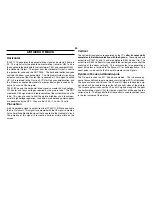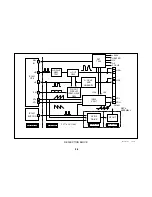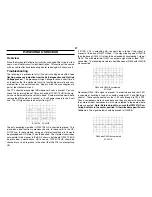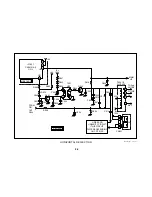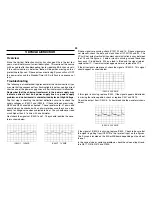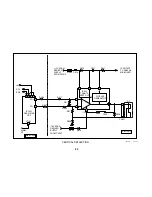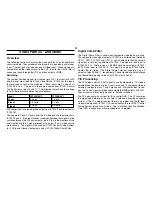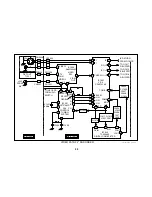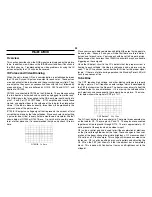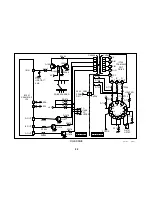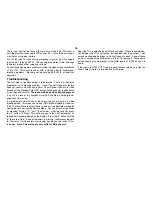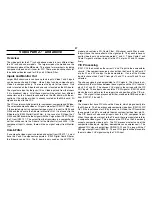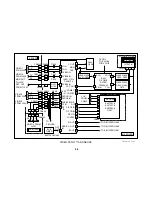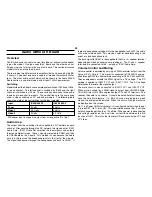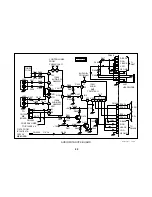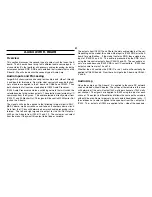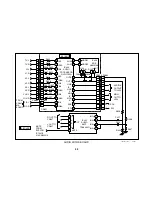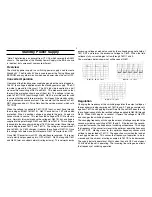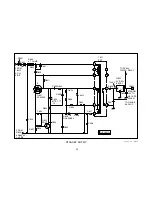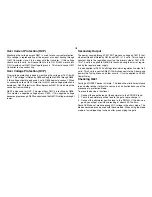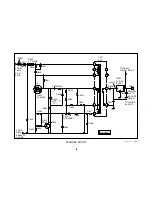
39
Audio without K Board
Overview
The BA-5 chassis can contain one of two types of audio circuits depend-
ing on the model. One type uses the K board and the other does not.
Screen size is not a factor in the use of a K board. This section discusses
models that do not use the K board.
There are also two different audio amplifiers that can be used by the BA-
5 chassis. The one shown here is used in all models that output 5Wx2 or
less. The other audio output, which will be shown in the Audio With K
Board section, is used for models with at least 10Wx2 power output.
Switching
Models without the K board use separate audio switches, IC405 and IC406,
for each channel. The left channel is switched by IC405 and the right
channel is switched by IC406. These switches each have three audio
inputs and two-control line inputs. The control lines are the same ones
used in video switching on 24” and under models. The following table
shows the state of the control lines for the input selected:
Input
IC405/406 S1
IC405/406 S2
Tuner
0 Volts
0 Volts
Video 1
3.3 Volts
0 Volts
Video 2
0 Volts
3.3 Volts
Whichever input is chosen is output from its respective IC at pin 7.
Audio Amp
The output from the switching circuit is applied to a RC network on each
channel. After passing through the RC network, the signals enter IC401
Audio Amp. IC401 Audio Out amplifies the input signals and outputs
them as a differential pair. These + signals are routed to CN407 and then
to CN408 both on the A board. This method is used because the Audio
amp is in the rear and the headphone jack is in the front of the A board.
The signal then passes through the headphones and back to CN407. If
there are headphones plugged into the headphone jack J401, the audio
will not be returned back. This may be useful for troubleshooting in the
event of a bad headphone jack.
The back signal to CN407 is then applied to the R+ or L+ speaker terminal
depending on which channel you are looking at. The R- and L- speaker
terminals are connected to the – outputs of IC401 Audio Amp.
Volume Control and Muting
Volume control is adjusted by varying a PWM waveform output from the
Syscon ICs O Vol pin. This signal is connected to CN2009/10 and ap-
plied through D403 to a filter network consisting of C440, C442 and R432.
These components smooth the PWM signal to a DC voltage. This DC
voltage is applied to IC401/1 VC1 and IC401/7 VC2. The DC voltage
determines the level of the signal output.
The mute circuit is also connected to IC401/1 VC1 and IC401/7 VC2.
When mute is called for, a HIGH signal is output from CN2002/9 Mute.
This HIGH turns Q410 ON and grounds the VC1 and VC2 terminals. This
reduces the audio to no volume. It should be noted here that these sets
have the Auto Mute feature. If a BA-5 chassis were tuned to a weak
station, the audio would be muted. When this occurs, No Signal will also
be displayed on the screen.
Q411 is a Power Off Mute transistor. It is configured so that when the set
is turned OFF, Q411 turns ON. This is possible because the + 9 volt line
holds voltage longer than the +12 volt line. When power is disconnected
and voltage remains on the 9-volt line, current flows between the B-E
junction of Q411. This turns the transistor ON and grounds the VC1 and
VC2 lines.
Summary of Contents for FD TRINITRON WEGA KV-13FM12
Page 27: ...22 NOTES ...
Page 48: ...APPENDIX ...

